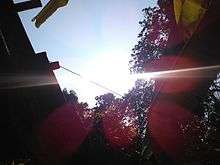Noon

Noon (also midday or noon time) is 12 o'clock in the daytime, as opposed to midnight. The term 12 p.m. (for post meridiem, and also written as 12 pm or similar variations thereof) is sometimes used for noon.
Solar noon is the time when the Sun appears to contact the local celestial meridian. This is when the Sun apparently reaches its highest point in the sky, at 12 noon apparent solar time. The local or clock time of solar noon depends on the longitude and date.[1]
In many cultures in the Northern Hemisphere, noon had ancient geographic associations with the direction "south" (as did midnight with "north" in some cultures). Remnants of the noon = south association are preserved in the words for noon in French (Midi) and Italian (Mezzogiorno), both of which also refer to the southern parts of the respective countries. Modern Russian, Polish, Belarusian, Ukrainian, and Serbian go a step farther, with the words for noon (полдень, południe, поўдзень, південь, пoднe – literally "half-day") also meaning "south" and the words for "midnight" (północ, поўнач, північ, пoнoħ – literally "half-night", as with English mid(dle) meaning "half") also meaning "north".
Etymology

The word noon is derived from Latin nona hora, the ninth hour of the day, and is related to the liturgical term none. The Roman and Western European medieval monastic day began at 6:00 a.m. (06:00) at the equinox by modern timekeeping, so the ninth hour started at what is now 3:00 p.m. (15:00) at the equinox. In English, the meaning of the word shifted to midday and the time gradually moved back to 12:00 local time (that is, not taking into account the modern invention of time zones). The change began in the 12th century and was fixed by the 14th century.[2]
Solar noon
Solar noon (informally high noon)[3] is the moment when the Sun contacts the observer's meridian, reaching its highest position above the horizon on that day ("Sun transit time"). This is also the origin of the terms ante meridiem (a.m.) and post meridiem (p.m.), as noted below. The Sun is directly overhead at solar noon at the Equator on the equinoxes, at the Tropic of Cancer (latitude 23°26′12.7″ N) on the June solstice and at the Tropic of Capricorn (23°26′12.7″ S) on the December solstice. In the Northern Hemisphere, north of the Tropic of Cancer, the Sun is due south of the observer at solar noon; in the Southern Hemisphere, south of the Tropic of Capricorn, it is due north.
The elapsed time from the local solar noon of one day to the next is exactly 24 hours on only four instances in any given year. This occurs when the effects of Earth’s obliquity of ecliptic and its orbital speed around the Sun offset each other. These four days for the current epoch are centered on 11 February, 13 May, 25 July, and 3 November.
It occurs at only one particular line of longitude each event. This line varies year to year, since Earth's true year is not an integer number of days. This event time and location also varies due to Earth's orbit being gravitationally perturbed by the planets.
These four 24-hour days occur in both hemispheres simultaneously. The precise UTC times for these four days also mark when the opposite line of longitude, 180° away, experiences precisely 24 hours from local midnight to local midnight the next day. Thus, four varying great circles of longitude define from year to year when a 24-hour day (noon to noon or midnight to midnight) occurs.
The two longest time spans from noon to noon occur twice each year, around 20 June (24 hours plus 13 seconds) and 21 December (24 hours plus 30 seconds).
The shortest time spans occur twice each year, around 25 March (24 hours minus 18 seconds) and 13 September (24 hours minus 22 seconds).
Nomenclature
In the US, noon is commonly indicated by 12 p.m., and midnight by 12 a.m. While some argue that such usage is "improper"[4] based on the Latin meaning (a.m. stands for ante meridiem and p.m. for post meridiem, meaning "before midday" and "after midday" respectively), digital clocks are unable to display anything else, and an arbitrary decision must be made.
An earlier standard of indicating noon as "12M" or "12m" (for "meridies"), which was specified in the U.S. GPO Government Style Manual,[5] has fallen into relative obscurity; the current edition of the GPO makes no mention of it.[6][7][nb 1]
However, due to the lack of an international standard, the use of 12 a.m. and 12 p.m. can be confusing. Common alternative methods of representing these times are:
- to use a 24-hour clock (00:00 and 12:00, 24:00; but never 24:01)
- to use "12 noon" or "12 midnight" (though "12 midnight" may still present ambiguity regarding the specific date)
- to specify midnight as between two successive days or dates (as in "midnight Saturday/Sunday" or "midnight December 14/15")
- to avoid those specific times and to use "11:59 p.m." or "12:01 a.m." instead. (This is common in the travel industry to avoid confusion to passengers' schedules, especially train and plane schedules.)
See also
Notes
- ↑ The 29th edition of the U.S. GPO Government Printing Office Style Manual (2000) section 12.9
References
- ↑ "The Sun as an Energy Resource".
- ↑ Online Etymology Dictionary
- ↑ "high noon". The Cambridge Advanced Learner's Dictionary & Thesaurus. Cambridge University Press. Retrieved 2016-12-19.
- ↑ Physics Laboratory FAQ "Times of Day"
- ↑ Style manual of the Government Printing Office / (Rev. ed.). Washington, D.C. :. 1923.
- ↑ "U.S. GPO Government Printing Office Style Manual Chapter 9". 2008. Retrieved 2009-06-11.
- ↑ "U.S. GPO Government Printing Office Style Manual Chapter 12". 2008. Retrieved 2009-06-11.